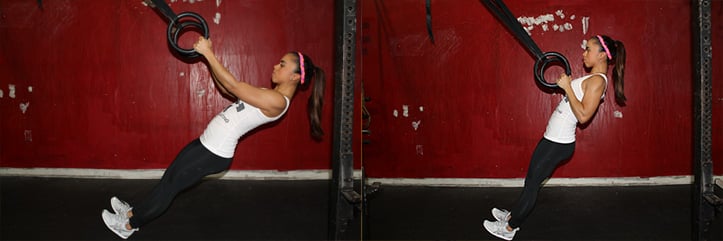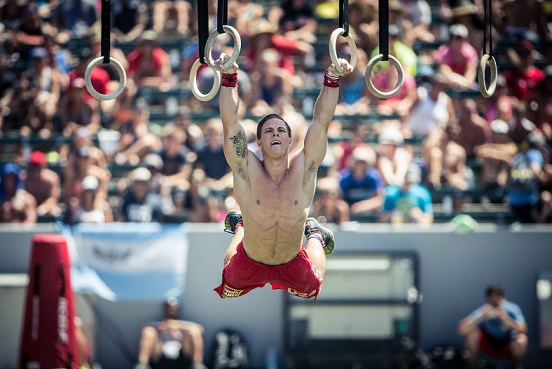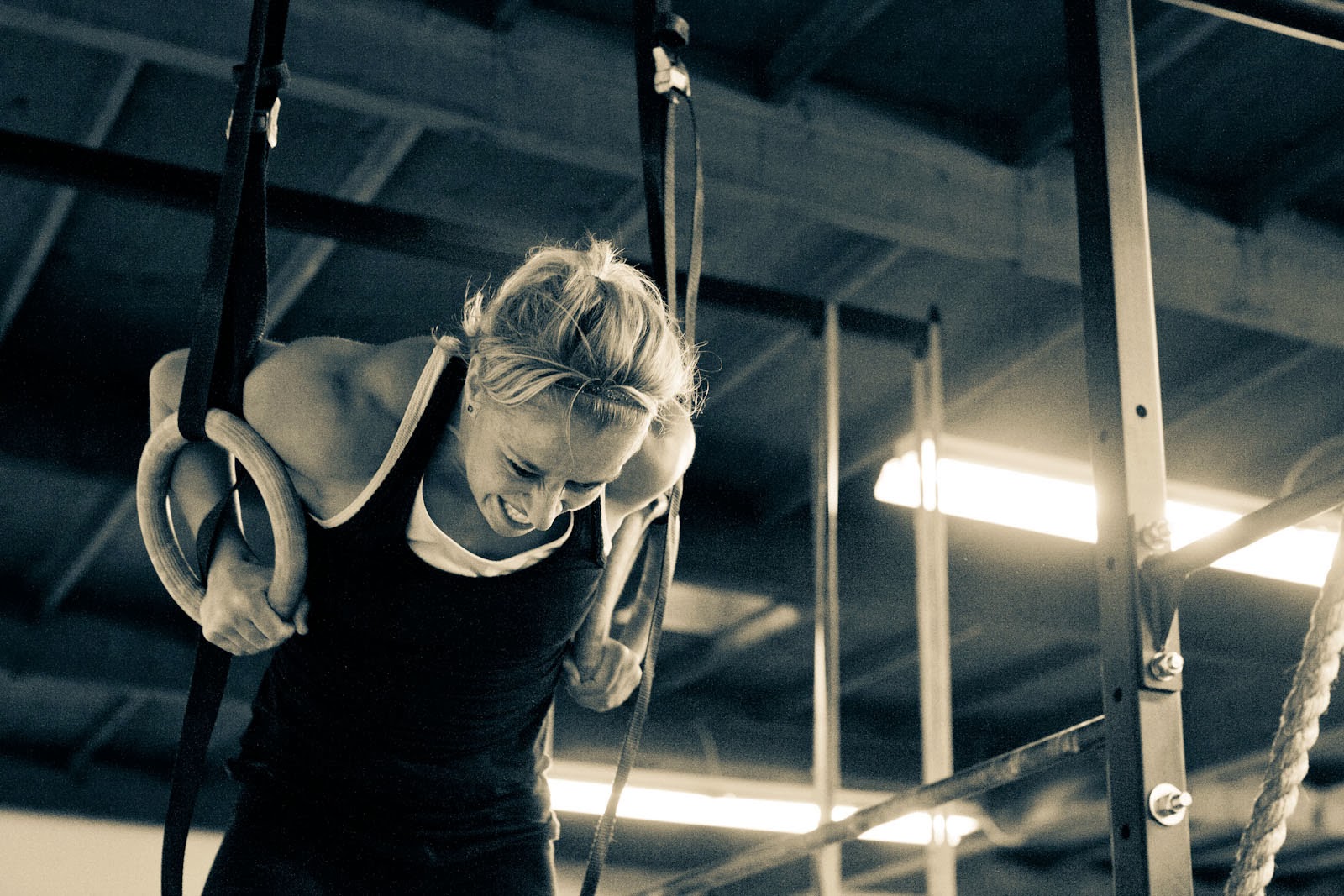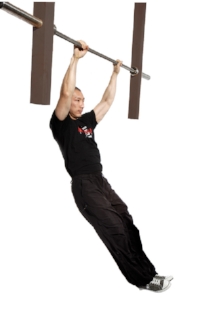Muscle-ups
Another milestone worth highlighting, the muscle-up is a particularly challenging movement for those in the CrossFit world who lack any previous gymnastics background.
It's easy to explain why people like them, though; once witnessed, why athletes who first step into a CrossFit gym set their sights on accomplishing a muscle-up.
Plain and simple, the muscle-up looks cool.
Muscle-ups are like that middle school crush-- attractive and popular and seemingly unattainable. And a lot like that fleeting feeling of teenage turbulence, if ever attained, muscle-ups can confusingly become more work than ever believed. It's because we're always wanting more, always striving to be better. One muscle-up is never enough, we want to string multiples together... and efficiently.
Keep these off the hot girl/hot guy pedestal, however, because a muscle-up is just like any other difficult movement in the gym. And there are plenty of those in the fitness sea.
So let's jump in head first to battle this beast from the depths of gymnastics lore and bring the muscle-up progression to light.
What prerequisite strength exists for a muscle-up?
Similar to our previous focus on pull-ups, let's clear up some prerequisites for strength and skill before looking at specific drills in the developmental progression of a muscle-up.
Naturally, we've come to realize the online hate of the gymnastics kip often utilized in CrossFit. "Cheating," it gets called. What's interesting is that we rarely see the sport of gymnastics get bashed for using momentum in competitive programs or in the Olympics every four years.
There's a reason for this: gymnasts, both men and women, have a baseline of muscle strength that allows them to safely use body momentum in their movements and routines.
Pull-ups Compared to a kip, strict pull-ups are a safer movement for a beginner. A strict pull-up helps develop muscle strength in the latissimus dorsi, the biceps, and to some extent the rhomboids and trees major in the back. These are similar pulling muscles involved in both the bar and ring muscle-up, so therefore it makes sense that a prerequisite for any muscle-up training is exactly that: a pull-up, both strict and kipping.
The movement of the gymnastic kip can be taught on the pull-up bar simultaneously as the strict movement to help embed the concept through routine, yet this involves some quality coaching. While upper body strength is acquired, so is the idea of generating momentum. Proponents of kipping cite the athleticism it requires and develops; coordination is necessary for hip recruitment in order to use swinging momentum correctly. The kip fosters a body awareness akin to other muti-joint movements we see in Olympic weightlifting or sport-specific actions like throwing or jumping.
Kipping practice can be done before or after a workout, although afterwards would generally mean a person works while fatigued. This is not immediately unsafe, but overtrain while already muscle fatigued and that's a recipe for potential disaster.
Just remember that kipping without at least some basis of strength is not productive.
Ring Dips If a CrossFit athlete has a kipping pull-up, the next requirement for the muscle-up is a ring dip. While box dips and stationary bar dips are all well and good, the rings obviously throw a snag into things because of the multiple planes of movement that the gymnastics rings allow. This stabilization is what we are seeking; that shaky movement will eventually tighten up.
Strength development tends to take time for the dips, plus, these are stereotypically quite difficult for women because of the necessary upper body control.
Shoulder Mobility The transition from the pull-up to the dip portion of a muscle-up requires stable but mobile shoulder sockets. Because the ring dip out of the muscle-up is initiated in a deeper starting position than usual, new athletes whose pull is not as experienced and therefore not as high up on the rings tend to struggle to turn their pull over for the transition.
Check mobility videos to maintain a healthy and prepared shoulder. It is an absolute necessity in the grind of a muscle-up; a stable shoulder is needed to turn through the very strength-intensive transition.
What progressions will help acquire a full muscle-up?
Getting the most from your work in the gym means being smart about what scaling options you have and how to correctly move up a progression to the real thing. This holds true with the muscle-up, both of the ring and bar variety.
Below are some options for strength and skill development:
Ring Rows: A great start for the absolute newbie. The more horizontal the body, the harder the ring row, but also be careful to try and emulate a more upright pull-up motion to work the lat muscles correctly.
- Do keep the core tight and complete the full range of motion for best results.
- Don't think these are for wussies. Ring rows can be brutal, even for the experienced.

Hollow Body Position: Underrated, at least on the pull-up bar, and usable not just as an exercise in itself. As a good counter balance, the hollow position builds core stability while keeping posture, on the bar in particular. This transfers to many other aspects in gymnastics and CrossFit.
- Do practice hollow rocks on flat ground and apply it to your starting position at the bottom of the muscle-up. A tight midline aids the stretch reflex during the loading phase of a kip as well.
- Don't get frustrated. Hollow positioning is not easy. (Unless you grew up a gymnast... lucky.)
Gymnastics Kip: A kip can be small or big in terms of the swing, and therefore can be used to eke out just one additional rep on a set of muscle-ups until failure or during a first muscle-up attempt with a humongous "load-up." Hips are essential, whether on rings or on the bar.
Working on stringing more consecutive bar muscle-ups? Remember to push away at the top to use a bigger "chest through" load-up swing in the later rep numbers as you near your max. On the rings, work neutral grip and allow the body to swing with hands pushed forward/out slightly to help a full kipping motion for success.
- Do generate power from the hips to get them up and turned over.
- Don't worry if you get a muscle-up, or multiples, and then "lose" them for a day or more. They come and go quite often. Stay at it.
Transition Work: A few options exist in working the transition of the muscle-up. A common one involves dropping the rings down to ring dip level or below, and allowing the feet to assist in getting from a ring row position to the bottom of the ring dip. See a video here for quick tips.
- Do work over time on using less legs will develop strength in the turnover. This is definitely different than a free-swinging kip to transition, however, so use this in conjunction with the next drill.
- Don't stay put in this drill from the ground. Full hollow body extension on the rings or the bar is quite a bit different and where you want to go with your progression.
Assisted Muscle-ups: A coach or partner can be a huge help in assisting that last portion of the pull to get on top of the rings/bar in the transition. This is great when the kip looks good and the ring dip out of the muscle-up can be obtained but it's that pesky transition that is holding everything back.
- Do keep the rings in tight to pull them along the chest to directly under the armpits. Shoot the chest through and look at the toes, if that helps.
- Don't pull to the bar or the rings, pull up and over.
Multiple Reps: Once one muscle-up has been achieved, obviously efficiency with multiple reps is the next goal. Kipping out of the bottom of the dip can happen with the legs behind a bit to continue to use momentum. A typical knees to chest kip for the dip can be utilized for those a bit slower and at the starting level of linking muscle-ups together.
- Do work on maintaining a tight midline and great hollow position to maximize hip drive for consecutive reps. At the very top, lean back and fall into the next forward swing.
- Don't get anxious. Be patient for the right time to pull on consecutive reps.
Strict Muscle-ups: In need of a whole other challenge? Dead hang muscle-ups are strictly for those ready. Pun intended. Use a false grip to help the wrist on top of the rings and get a big pull before working to crank the elbows back and chest on top of the hands.
See videos here and here for great visuals on the body positions needed to complete this huge piece of muscle-up extra credit.
Now you'll really impress the popular kids.
Get a video so you can see yourself move, ask for coaching cues, and then celebrate your success with the public. This is one feat that deserves bragging about. No fish tales, however-- be honest, be persistent, and good luck!
- Scott, 8.11.2015









